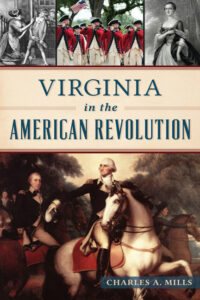BOOK REVIEW: Virginia in the American Revolution by Charles A. Mills (Charleston, SC: The History Press, 2025) $24.95 paperback
Why were Revolutionary War events in Virginia significant, and what was it like to reside in the rebelling colony? Charles A. Mills, a historian and prolific author, answers these questions in his new book on Virginia’s role in the American Rebellion. This is Mills’ seventh volume on the American Revolution. Additionally, he has authored over fifty books spanning American History and alternative history fiction, with many focused on the Cavalier state.
 The narrative begins with the story of John Carlyle, an Alexandria merchant who received shabby treatment by the British in the French and Indian War. The author argues that Carlyle’s experiences were emblematic of growing antagonisms between superior-thinking Royal authorities and Virginians. The book then provides an overview of revolutionary events in Virginia, featuring prominent politicians and military leaders. In a few pages, Mills describes how the animosities moved from a war of words to an armed conflict, independence, and victory at Yorktown. A highlight is a reprint of George Mason’s Declaration of Rights adopted by the extralegal Fifth Virginia Convention. Many contemporary American freedoms and aspirations are found in this enlightened document.
The narrative begins with the story of John Carlyle, an Alexandria merchant who received shabby treatment by the British in the French and Indian War. The author argues that Carlyle’s experiences were emblematic of growing antagonisms between superior-thinking Royal authorities and Virginians. The book then provides an overview of revolutionary events in Virginia, featuring prominent politicians and military leaders. In a few pages, Mills describes how the animosities moved from a war of words to an armed conflict, independence, and victory at Yorktown. A highlight is a reprint of George Mason’s Declaration of Rights adopted by the extralegal Fifth Virginia Convention. Many contemporary American freedoms and aspirations are found in this enlightened document.
Part two of the book lists the state’s interesting Revolutionary War sites in alphabetical order by county. The historically significant locations include churches, battlefields, plantation homes, and government buildings throughout the Commonwealth. In addition to well-known places such as the Yorktown battlefield and Mount Vernon, Mills describes more obscure but interesting commemorative spots. For example, a cultural center in South Boston, Virginia, contains an exhibit on Maj. Gen. Nathanael Greene’s Crossing of the Dan campaign in 1781. Another site is Richmond’s St. Johns Church, where Patrick Henry uttered the fiery words, “Give Me Liberty or Give Me Death.” Henry’s complete speech is reprinted along with a description of the church and a schedule of annual commemorative ceremonies.
Part three presents Mill’s argument that today’s readers should know more about “the day-to-day social reality of the people of Virginia at that time” (page 9). Social topics include slavery, religion, travel, family life, clothing, and entertainment. In this section, the author returns to John Carlyle to recount several personal tragedies that are representative of those faced by people in the late eighteenth century. On the positive side, readers will enjoy learning about fashionable male and female hairstyles and learning that Martha Washington was a “clothes horse.” In Mills’ view, she may not have been the “frumpy, dumpy” lady depicted by other historians (p. 79).
The next section describes military life, including service in the militia and Virginia Continental Army regiments. While not usually associated with the Old Dominion, its militia included minuteman units similar in organization and purpose to the more famous New England version. At the war’s outset, Virginia planned to raise fifteen regiments to support the Continental Army. As the war progressed, the number of regiments declined precipitously. By 1781, the state could only deploy a few regiments in the Southern theater, most notably at the Battle of Guilford Court House in North Carolina. Mills notes that each regiment had one or two fifers and drummers to relay commands and regulate camp life, which is often overlooked.
Other military life topics include the complex and varied history of Black combatants on both sides, the small, ineffective Virginia Navy, and several stories about the King’s troops and hired soldiers. Virginia housed captured British and Hessian combatants, whom the Rebel government induced to defect with offers of land and freedom. Another story depicts a British force under Lt. Col. Banastre Tarleton capturing three Virginia Third Detachment battle flags at the Battle of Waxhaws. These flags remained in the Tarleton family until an anonymous buyer purchased them at auction for five million dollars in 2006.
Readers may find the last section of greatest interest, which recounts personal stories and unusual events. The most notable are seven accounts of extraordinary women, including the life of Anna Maria Lane (1755-1810), “the only documented case of a woman dressing as a man and fighting on the battlefield” (p. 105). Lane spent five years in the Continental Army and received a Virginian pension for her service in 1808. Other stories include the case of former George Washington slave Henry Washington, who helped found Sierra Leone in Africa, James Armistead, who spied for General Lafayette, and a curious allegiance twist in the noble Fairfax family.
This book is most useful for those seeking an introduction to the American Revolution in Virginia. It is casually readable and contains noteworthy human-interest stories. The author’s readily apparent fascination with Virginia’s history will spark visiting Virginia’s historical sites and learning more about the Commonwealth’s vital contributions to the Rebellion. Mills ably demonstrates his assertion that more should be written about what it was like to live in the Revolutionary Era.
PLEASE CONSIDER PURCHASING THIS BOOK FROM AMAZON IN PAPERBACK OR KINDLE.
(As an Amazon Associate, JAR earns from qualifying purchases. This helps toward providing our content free of charge.)





Recent Articles
Entangled Alliances: Racialized Freedom and Atlantic Diplomacy During the American Revolution
Videau’s Bridge: An American Disaster After Yorktown
This Week on Dispatches: Geoffrey Hoerauf on American Spies around Fort Detroit
Recent Comments
"A Curious Agreement Among..."
Mr. Ness, I would love to have a copy of that list....
"Unraveling the Mystery of..."
This is superbly researched and I think you perfectly settled the matter....
"The New Dominion: Virginia’s..."
Thanks, Eric! There's more to come on this. Three generations of my...